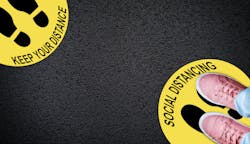2020 has been a year. That’s probably the understatement of the year, closely followed by, “I’ve never been more excited about getting a shot.”
In December 2019, the world was just discovering the novel coronavirus, and most of us were continuing with business as usual. A few months later, most plans were thrown out the window and the country largely ground to a halt because of COVID-19, the virus caused by SARSCoV-2.
Companies collectively rose to the occasion, and so did all of you. You’ve been doing amazing work these past months by finding ways to help the general public while keeping your co-workers and their loved ones safe. We salute you. We know it’s no small feat to balance the daily (and sometimes hourly) needs of a changing workforce and working environment while also focusing on long-term challenges and goals. After all, there are other safety hazards to prevent, and the Occupational Safety and Health Administration (OSHA) will continue to enforce all safety precautions.
As 2020 comes to a close, we look back on a year that we won’t soon forget (and will likely feel the reverberations of for years to come). Here are the top 10 issues impacting safety professionals in 2020, as reported in our print magazine, on our website, in one of our digital products, or on one of our social media channels. Our thanks to EHS Today’s editorial staff and all others who contributed to our coverage throughout the year.
1. Respirators
Many workers are already required to wear respirators, safety glasses and gloves. Those and other personal protective equipment (PPE) quickly became scarce. In April, media outlets such as Business Insider reported nurses and doctors were wearing garbage bags and reusing N95 respirators, if they were lucky enough to have one at all.
In the spring, the Centers for Disease Control and Prevention (CDC) recommended the general public wear facemasks to protect themselves from getting and spreading COVID-19 to others when in close contact with people outside the household. The CDC recommended cloth face coverings to ensure those in healthcare and other industries had a fighting chance at securing N95 respirators.
That prompted OSHA to issue temporary guidance permitting extended use or reuse of respirators in certain circumstances and to develop contingencies in case of respirator shortages. Suppliers still haven’t been able to keep up with the increased demand. “Employers should carefully review the OSHA guidance and adjust their respiratory protection practices accordingly,” recommends attorney Bradford T. Hammock with Littler Mendelson PC.
2. Social Distancing
We now know COVID-19 most commonly spreads through close contact with an infected person. In October, the CDC amended the definition of close contact as “someone who was within 6 feet of an infected person for a cumulative total of 15 minutes or more over a 24-hour period starting from two days before illness onset (or, for asymptomatic patients, two days prior to test specimen collection) until the time the patient is isolated.”
Social distancing, along with wearing face masks and increased sanitization, are currently our best defenses against COVID-19. Implementing distance of at least 6 feet between workers can be a challenge, however, as workspaces have largely been designed for space optimization rather than maintaining safe distance. EHS professionals and company executives have worked to find a variety of ways to help employees keep their distance from others to reduce the possibly of catching or spreading COVID-19.
Companies have staggered shift starts and breaks to help reduce large gatherings of employees. Schedules have been altered so people are working in teams to help contain potential outbreaks. The number of employees in the building or on the floor at any given time may be lowered to ensure distance can be maintained. Workflows have been reconfigured. Conference rooms have been turned to break rooms. And while some of these measures may be temporary, they may offer long-term benefits.
“The same tools that help manufacturers cope with new safety rules can deliver added benefits over the longer term,” notes Ray Almgren, COO of Swift Sensors, a developer of cloud-based wireless sensor systems for industrial applications. “Adapting to the new normal in manufacturing is a challenge, but the result can be a safer workforce in a plant that operates more efficiently, protects its resources better and can recover from the downturn faster.”
3. Wearables
For years, as wearable devices like fitness trackers and smart watches dominated the consumer spaces, companies explored what impact those or similar devices could have on the workplace. COVID-19 has offered practical applications that are driving the market.
EHS research and consulting firm Verdantix reports that year-on-year growth rates for connected worker solutions now range from 30% to 200%.
“When we surveyed 102 buyers of industrial wearables in 2019, only 6% planned to increase spending by 10% or more,” comments Hugo Fuller, Verdantix analyst.
Companies hoping to curb the spread of or isolate exposure to COVID-19 are turning to connected worker solutions that can enhance contact tracing. Wearable wristbands and badges can alert workers when they are too close. Employees can use the device platforms to self-report infection, and deidentified location information can alert other employees who were in close proximity to self-isolate and seek testing.
These devices can also be used for reporting accidents or near misses in real time and offer just-in-time learning or servicing with augmented reality (AR) technology. AR allows employees to see what to do and, in some instances, connects them with a specialist who can help troubleshoot potentially without being on site. That can lower close contact and even lead to faster repairs.
4. Racism
The murders of George Floyd, Breonna Taylor and Ahmaud Arbery, among many others, are changing the conversation of race and racism in America.
Following their murders, people erected memorials and murals around the globe. They also took to the streets to protest racism, biases and police brutality. This movement has carried over into the workplace. Several company executives have spoken to employees and their customers about realities long ignored and oft brushed aside in the workplace.
“We can’t afford to stand on the sidelines. As human beings, we have an obligation to take an active role as to what’s going on in our country,” says Jaime Irick, PPG vice president, architectural coatings, U.S. and Canada. “We have been having frank conversations, up and down the organization. As a Black executive for about 20 years, I have always had these conversations and now everyone at the company is doing the same. We talk about perceptions and we talk about unconscious bias.”
These conversations aren’t always comfortable, and efforts to create a more diverse, equitable and inclusive workplace require both time and money. It’s noteworthy that during a global pandemic, which has disproportionately affected people of color, the American Medical Association has declared racism a public health crisis. Employers have an obligation to keep their employees safe at the workplace, and that includes fall hazards, COVID-19 and racism.
5. Mental Health
COVID-19 has demonstrated a need for employees and employers alike to address the issue of mental health. While some companies have programs in place, there is still opportunity for improvement.
In August, the CDC announced that almost 41% of all adults in the United States are struggling with their mental health or substance use, double what had been historically reported pre-pandemic.
A separate study conducted by APNORC and SAP found that of 1,015 surveyed employees, about one-fourth were considering quitting their job.
“In dealing with COVID-19, it’s important to formalize the fact that we are all experiencing some level of anxiety, loneliness and isolation,” says Darcy Gruttadaro, J.D., director of the Center for Workplace Mental Health, American Psychiatric Association Foundation. “Normalizing these feelings helps people feel comfortable in sharing their feelings. And if the top leadership is open as well, it helps create a culture that can address mental health issues.”
In addition to the pandemic, there is an ongoing mental health crisis in construction. The CDC released a study in January 2020 that found the total suicide rate among all men was 27.4 individuals per 100,000. The rate was 49.4 for men who worked in construction.
6. Communication
Communication has assumed even greater importance during a pandemic. It’s how management can convey new protocols to employees who are no longer gathering in the break room and as regular meetings may be altered to adhere to social distancing measures. Employers need to be able to describe changes in existing practices as well as new policies or procedures that have been enacted to protect employees. These new measures have been updated or refined over the past nine months as scientists, healthcare providers and public health experts have learned more about COVID-19.
“In times like these, communication can make or break your health and safety program,” writes Angelo Cianfrocco, an environmental, health and safety professional. “Effective and timely communication will go a long way to helping you get your message out, while also providing a system for employees and managers alike to count on for guidance, knowledge and advice.”
Employees who are working remotely have made it even more important for employers to be able to communicate frequently across their workforce. Depending on the diversity of the workforce, that could mean disseminating information in multiple languages. New technology (apps, text alerts) or devices (wearables) may need to be deployed to ensure everyone has access to the latest information in a method they can understand.
Communication can go a long way to reassuring employees that it is safe to come to work, that what they are doing matters, and that they will have access to resources or care should they need it. Two-way communication is especially important to prevent an outbreak in the event of COVID-19 exposure.
7. Virtual Training
Standard training procedures may no longer be possible. COVID-19 has forced companies to systematically review, rethink and reimagine employee onboarding and training. Virtual learning offers a chance for companies to create standardized documents and videos to ensure all employees have a baseline knowledge of proper safety protocols.
Virtual reality/augmented reality (VR/AR) allow employees to learn without putting them in potentially unsafe situations. VR/AR technology can support just-in-time learning to teach employees in a more flexible, on-demand and accessible format. The technology lends itself to gamification to create fun, immersive and potentially more memorable learning experiences than listening to hours of lectures or reading pages of materials.
Virtual training can be updated and quickly pushed out across the workforce to ensure all employees have completed the latest training. Quizzes can offer quick feedback about where additional training may be needed and a proactive way to follow- up with individual employees.
“We’ve always talked about simulation,” says Raj Batra, president of digital industries for Siemens USA. “We’ve talked about doing things virtually before you do it physically, and I think this is critically important — now more than ever, where you physically can’t always be there.”
8. Remote Work
When state and local government officials ordered shutdowns, millions of people suddenly went from working in an office to working from home. That has posed a number of concerns for companies, including ensuring employees had the equipment they needed and that their security networks weren’t vulnerable to cyberattacks.
Employees have proven they can do the job even from less-than-ideal situations, say a dining room table, perhaps seated next to their children doing remote learning.
As the months have dragged on, there are growing concerns about how to help employees who may be feeling less connected to their co-workers, overwhelmed by this new normal and at risk of burning out. The same technology that can lead to feelings of isolation can also be used to create camaraderie.
“It takes more than a laptop and conference calls,” observes Donna McEntee, director of EHS products at Skillsoft, a provider of cloud-based corporate learning content. “Engagement, productivity and technology training are legitimate concerns, especially for companies without established work-from-home policies. Leaders have to learn to maintain operations and productivity with less direct influence. Leading virtually is a learned skill. Similarly, virtual workforces require employees to rethink collaboration—technology does not equal teamwork.”
9. Cyberattacks
Businesses, especially the manufacturing sector, have been a recent target for hackers seeking to cause chaos or make money by disrupting business operations.
A March 2020 report, Securing Critical Operational Technology in Manufacturing by the Manufacturers Alliance and cybersecurity firm Fortinet, found that a majority of companies faced at least one specific security incident that resulted in unauthorized access to data in the past 12 months, a sizable jump from just a few years ago.
Data protection and managed services provider Digital Guardian published a report by aggregating anonymized telemetry from Jan. 1 to April 15, 2020, from 194 global companies. They found a 123% increase in employees copying company data to USB drives, 74% of which was classified. They also found a 62% increase in malicious activity, which led to a 54% increase in incident response investigations.
“Cybercriminals are not only aware of, but are actively targeting, workers who are remotely accessing confidential and sensitive corporate information,” say attorneys John P. Rondini and Todd W. Dishman of the law firm of Brooks Kushman. “Just as hand washing is critical to stop the spread of COVID, good cybersecurity ‘hygiene’ is required to prevent cyberattacks in this time of crisis.”
Ransomware and spyware also pose serious risks, highlighting the need for companies to train employees on how to identify malicious emails and ensure their devices are up to date and all security patches are installed.
10. 3D Printing
3D printing, or additive manufacturing, is poised to revolutionize manufacturing and the supply chain. The 3D printing market grew to more than $10.4 billion in 2019 and recent forecasts say this market will grow to $55 billion by 2029, according to a market report from SmarTech Analysis.
What’s more, 85% of manufacturers reported that industrial-scale 3D printing has the potential to increase revenue for their business, according to a survey by industrial 3D printing solution provider Essentium.
Companies like HP say that 3D printing can help the environment because it will enable the manufacturing industry to produce less waste, less inventory and less CO2 emissions. Nearly one-third of carbon emissions are related to the production and distribution of goods.
“3D printing is no longer a novelty, as manufacturers in the automotive, aviation, medical, consumer goods, entertainment and numerous other industries are integrating 3D printing into their production processes,” say Alexander Woo and Lauren A. Bachtel of the law firm of Hunton Andrews Kurth.
The Environmental Protection Agency (EPA) is now turning its attention toward 3D printing to study possible harmful emissions during the printing process. Chemical Insights, an institute of Underwriters Laboratories, and Georgia Tech have found that many desktop 3D printers generate ultrafine particles (UFPs) and numerous volatile organic compounds (VOCs) while in operation that may affect human health. UFPs can be inhaled and penetrate deep into the human pulmonary system, triggering lung irritation, respiratory and chest discomfort and asthma. VOC exposure can result in headaches, eye and nose irritation and flu-like symptoms.
While there are some occupational standards and guidelines for protecting workers in industrial environments mainly addressing specific VOCs and total particles, they do not address UFPs or many of the VOCs found in 3D printing emissions











